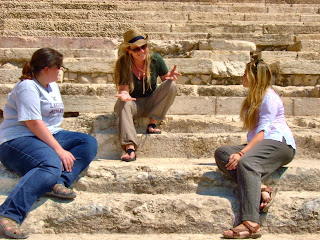An Interview with Mary Ann Beavis on the Gospel of Mark
Mary Ann Beavis, professor at the University of Saskatchewan, has written an excellent, mid-size commentary on Mark's Gospel for the Paideia series. This commentary does a fine job in introducing the reader/student to the Second Gospel without being unwieldy in its size and presentation. I heartily recommend her work to student, pastor and scholar alike. You can purchase a copy here.
Recently, Mary Ann was kind enough to answer some questions about her contribution to the Paideia series.
It’s more like returning to Mark after a long hiatus, since most of my work since my Ph.D. has been non-Markan. My dissertation on Mark 4:11-12 was published as Mark’s Audience by Sheffield Academic Press in 1989, and has recently been adopted for reissued by Bloomsbury Academic, but other than that that, my publications have been in the areas of parable studies, feminist interpretation of the bible, and religion and popular culture. However, I supervised an M.A. thesis on Mark in the early 2000's that reignited my interest in the Gospel, and when I was offered the opportunity to write the Paideia commentary, I was very happy to take it on.
2. Discuss your process in writing this commentary and the challenges of writing one for the Paideia series.
I spent more than a year reviewing the recent academic literature (which is voluminous) on Mark, and translating the Greek text for my own use (although the translation chosen by Baker for the series is the NRSV). Then I spent about a year writing the first draft of the manuscript, plugging away in my “spare time” between classes and other responsibilities. I think it took at least another year for the peer review, revisions and editing to be finalized. One of the big challenges in writing any commentary is just finding the time, since I wasn’t due for a sabbatical. With respect to the Paideia series, it’s a matter of pitching the work so that it’s academically worthwhile, and at the same time making it accessible to students and interested non-specialist readers.
3. One of the hotly-debated issues on Mark’s Gospel, and the Gospels as a whole, is the issue of genre. Much of the consensus today seems to liken the Gospels to Greco-Roman biographies. In what ways does Mark’s Gospel resembles an ancient Hellenistic tragedy?
One thing I discovered in writing my doctoral dissertation, which tried to interpret the Gospel in Greco-Roman rhetorical terms, was that several scholars before me (and many since) have seen similarities between Mark’s plot structure and the structure of Greco-Roman tragedies. My contribution, such as it is, was to see a parallel between the structure of the five-act Hellenistic play (the best extant example of which is by an Alexandrian Jew, based on Exodus) and Mark, with its alternations between extensive sections of narrative and teaching resembling the act/chorus/act of ancient dramas. Admittedly, this may be coincidental, but it is helpful in the attempt to discern structure in the Gospel. I differentiate between the plot structure of Mark, which is highly reminiscent of the tragic plotting mapped out by Aristotle in the Poetics, and the way the materials are actually arranged in five “acts” (narrative) punctuated by teaching sections, analogous to the structural role of the chorus. That said, I don’t regard Mark as a Greek tragedy or Hellenistic drama, but see these as part of the cultural mix that shaped the evangelist. This cultural milieu certainly included Greco-Roman biographies, and, equally or more importantly, the Jewish scriptures, which provide an important model for Mark’s portrait of Jesus. I don’t think it’s too audacious to suggest that the evangelist was attempting to write a scripture-like composition about a figure of “biblical” proportions.
4. How does the term euangelion function in Mark 1:1?
Like most other scholars, I think its meaning is twofold: it’s the “good news” about Jesus Christ, but even more so, it’s the “good news” preached by Jesus. For the Markan Jesus, the “gospel” is first and foremost the “good news of God”/the reign of God (Mark 1:14-15.
5. In the parables contained in Mark 4:1-34, how does the Parable of the Sower (4:3-9), shed interpretive light on the parable of “the seed growing secretly” in 4:26-29?
The two parables contain a lot of similarities—a sower, seed cast on the earth that sprouts and grows, and a threefold growth pattern. Both can be related to missionaries of the reign of God, whose efforts will inevitably lead to a harvest of believers, whether the preachers know it or not.
6. What are some of the literary elements shared between Mark 4:1-34 and Mark’s eschatological discourse in 13:1-37?
They are two lengthy discourses that “bracket” the Gospel; the parable chapter repeatedly exhorts the reader/audience to “hear”, and the eschatological discourse contains the repeated exhortation to “see” or to “watch”. Both themes are encapsulated in Mark 4:11-12, and are developed throughout the Gospel.
7. How does the original ending of Mark (16:8) invite readers to participate in the Markan drama?
Literarily, it’s an “open ending”, challenging the reader/audience to respond in faith rather than in fear or misunderstanding, as the disciples characteristically, including the women in 16:8.
8. In what ways do you hope/anticipate your commentary is utilized by students of Mark’s Gospel?
I hope that students will find the commentary to be a reliable guide to the historical, literary and theological dimensions of the Gospel, but even more, like the open ending of Mark, to encourage readers to exercise their critical faculties and imagination in their engagement with the text.

Comments